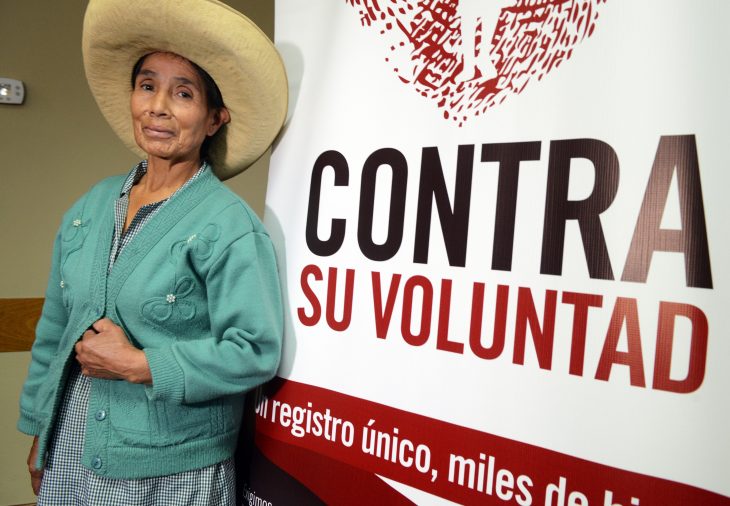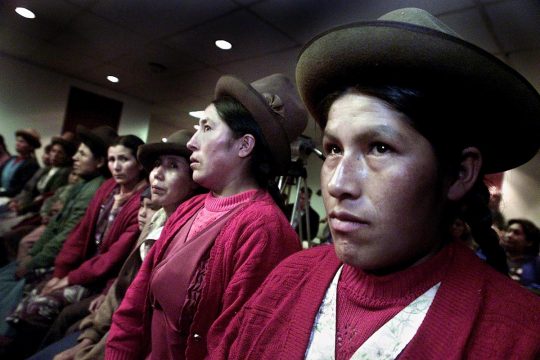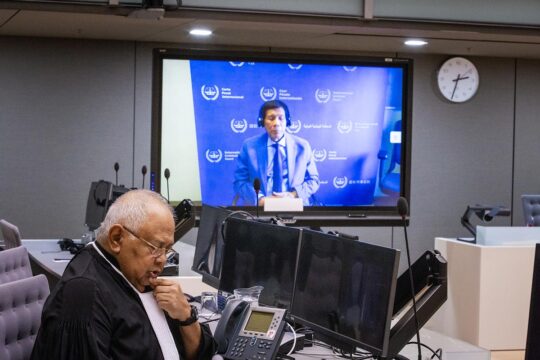Justice and redress for alleged victims of forced sterilization have long been prorogued on Peru’s transitional justice agenda. The Ombudsman (2002) and the Truth and Reconciliation Commission (2003) reported that this practice was common place during ex-President Alberto Fujimori’s mandate and potentially affected around 300,000 persons, mainly rural workers and indigenous women.
They were allegedly surgically sterilized without their consent via the Reproductive/Family Planning Programme (1996-2000) implemented to control the population growth in accordance with economic development goals. Only in April 2015 the Prosecutor re-opened an investigation into the alleged forced sterilizations of over 2,000 people. Fujimori and others, mainly ex-Healthcare Ministers, are currently being investigated. Additionally, via legislation and other regulations (late 2015), Peru’s Ministry of Justice and Human Rights has begun registering forced sterilizations victims (1995-2001), which would create the pressure for the institution of new restorative justice measures. This contribution outlines and examines the justice initiatives involved.
Justice initiatives: characteristics and challenges
The re-opening of the investigations into forced sterilizations has paved the path to justice for victims. The Prosecutor considered those crimes serious human rights violations. This is consistent with the 2003 Friendly Settlement Agreement between Peru and petitioners at the Inter-American Commission of Human Rights when Peru promised to investigate the case of María Mestanza who died after surgical sterilization. The obligations to investigate, prosecute and punish gender violence are established under the Inter-American Convention on the Prevention, Punishment and Eradication of Violence Against Women and the American Convention on Human Rights. Nevertheless, no reference was made to other applicable treaties to which Peru is party, including the Statute of the International Criminal Court (ICCS). As forced sterilization is criminalized as a crime against humanity- and also war crime-under the ICCS, reliance on this instrument would contribute to legally delimit forced sterilization under international standards and raise awareness of the need to incorporate this offence as a crime against humanity/war crime into Peruvian legislation.
The Prosecutor considered the victims’ right to the truth as a ground to re-open the investigation. Despite its absence in human rights treaties, the Inter-American Court of Human Rights (IACtHR) (e.g., Bámaca-Velásquez) and the Human Rights Committee (e.g., Sarma) have recognized it. The Prosecutor also found that the accused’s right to be tried without unwarranted delay is not absolute and must be balanced with the State’s duty to exhaustively investigate serious human rights violations.
Forced sterilization complaints are investigated as crimes against humanity, i.e. “committed as part of a widespread or systematic attack directed against any civilian population, with knowledge of the attack” (ICCS, article 7(1)). Forced sterilization is “biological reproductive capacity” deprivation, “neither justified by the medical or hospital treatment of the person[s]...nor carried out with their genuine consent” (ICC Elements of Crimes, article 7(1)(g)-5). Not only over 2,000 persons claimed to have been forcibly sterilized across Peru (“widespread”), but also those cases happened within a state program (1996-2000) (“systematic”), and mainly against peasant and indigenous women (“civilian population”). In turn, planning and executing the sterilization programme would suggest accused’s knowledge. Victims’ claims of coercion, particularly through verbal abuse, indicate absence of (genuine) consent and, thus, would prove the existence of irregular surgical sterilizations. Moreover, the fact that an important number of victims were illiterate or had very basic education complicates the issue of consent.
The 2,000 complainant figure is likely to increase as the recently instituted victim registration program continues. The government, in cooperation with civil society, must give those who regard themselves as victims all needed help to file their complaints and, later, participate as civil parties and/or witnesses to support the Prosecution and/or claim reparations in trial. The investigation should be comprehensive so that the case accurately reflects what occurred and must be conducted without undue delay as victims have seen no justice for many years. All Peruvian political forces, monitored by international organizations and actors, should commit to guarantee the success of this case during the new administration (July 2016-2021).
Concerning the 2015 victim registration legislation, three points should be mentioned. First, the victim definition is flexible as the lack of the victim’s free and informed consent suffices and coercion is not required. It is furthermore comprehensive as it includes not only judicially declared victims but also those who meet the registration requirements. This is important as several years may elapse until the case judgment is rendered. Second, the victims’ right to access to justice is made effective via the provision of free legal counselling and regardless of the victim’s registration. Victims are also assisted by interpreters during registration process in order to assist those who do not master Spanish. Third, victims are given psychological counselling and healthcare as well as social assistance. Although the said psychological and healthcare services are not part of reparations programmes or awards, they address the victims’ psychological and psychical harm and, thus, afford victims some restorative justice. In any event, all services should be accessible where victims live.
However, the 2015 legislation neglects a reparations programme for forced sterilization victims. The legislator lost an excellent opportunity to introduce a holistic transitional justice approach, particularly, restorative justice. This is compounded by the fact that the 2006 National Reparations Programme Rules contain no explicit reference to sexual violence victims as reparations beneficiaries, letting alone forced sterilization victims. The 2015 legislation rehabilitative measures, which involve psychological counselling and healthcare, are worded as humanitarian or assistance measures rather than reparations stricto sensu. Thus, there is no reparations programme tailored to the specific needs of sexual violence or forced sterilization victims. Furthermore, international case law (e.g., Fernández-Ortega (IACtHR) and Lubanga (ICC)) and the UN Principles and Guidelines on the Right to a Remedy and Reparation for Victims of Serious International Law Violations make clear that victims should be afforded adequate and effective reparations, which normally requires symbolic, rehabilitative and monetary reparations modalities – i.e., not only rehabilitation.
Challenges of implementation and positions of main stakeholders
With respect to investigation and prosecution, the most important implementation challenge is whether and to what extent the Peruvian judicial system as well as parties are prepared to efficiently and timely handle a highly complex criminal case with a very large number of victims. As this case involves sexual violence, special procedural and evidentiary rules adopted by the Supreme Court (2011) are to be tested. The fact that a significant number of victims is illiterate, lives in remote locations and suffered forced sterilization 15-20 years ago, further complicates the case. Moreover, this is the first judicial case of forced sterilizations as crimes against humanity in Peru. Thus, international cooperation will be needed via, for example, amicus curiae, legal training, forensic/medical expertise, to support national justice efforts.
Concerning victim registration, the identification of reparations beneficiaries should be comprehensively conducted. However, an important challenge is the laborious task of reaching out to the total universe of victims – potentially around 300,000 persons – in a timely fashion. This is particularly difficult as most victims belong to rural and indigenous communities, and are also categorized as vulnerable and dispossessed groups. The timely processing of all registration applications places a heavy burden on the state apparatus. The State has instituted decentralized mechanisms to reach victims within a reasonable timeframe. Victim registration is following a regional call approach and, thus, brought to where victims live and is conducted in their language. Since medical examination/certification proving sterilization is required for registration, the state healthcare system must offer free gender-sensitive assistance.
The State should also take victim-friendly steps when designing and implementing a reparations programme, combining individual and collective reparations. It should for example create a gender-sensitive reparations programme specifically tailored to redress harm inflicted by forced sterilization. International case-law on reparations for sexual violence victims (e.g., Rosendo-Cantú (IACtHR)) may be illustrative when implementing individual and/or collective reparations measures and programmes focused on redressing harm out of sexual/gender violence crimes. Although the State has yet to design and implement a reparations programme on forced sterilization, victims and NGOs have expressed the need for compensation.
Victims, their lawyers (NGOs), and an important sector of Peru’s political spectrum have welcomed the current administration’s justice initiatives. Thus, the main local stakeholders are in one way or another expected to contribute towards handling the implementation challenges. Despite criticising the timing of the current administration’s initiatives – a few months before presidential elections – even Keiko Fujimori, leader of the political movement started by her father Alberto Fujimori, has stated her interest in continuing investigations into forced sterilization if she becomes Peru’s President this July. However, victims are quite sceptical of her statements. Whether she would grant presidential pardon to her father, who was convicted for other serious crimes, is also to be seen.
To guarantee full implementation of justice and redress for forced sterilization victims, the UN, the Organization of American States – particularly their human rights bodies – and international NGOs must closely monitor the new Peruvian government’s commitment to the pending transitional justice points concerning forced sterilization victims, support local actors’ initiatives, and condemn any stagnation or step backwards.
Therefore, the aforementioned initiatives are important by themselves and complement each other. These initiatives have arguably catapulted forced sterilization victims to the forefront of Peru’s transitional justice agenda. Nevertheless, victims’ achievement of justice and reparations will ultimately depend upon how committed local, international, state and non-state actors truly turn out to be.
Juan Pablo Pérez-León Acevedo has a PhD in international law (Abo Akademi University, Finland); LLM (Columbia University, USA); LLB (Catholic University of Peru). He has served in diverse capacities at, among others, the International Criminal Court, International Criminal Tribunal for the former Yugoslavia, Abo Akademi University, and human rights NGOs.






